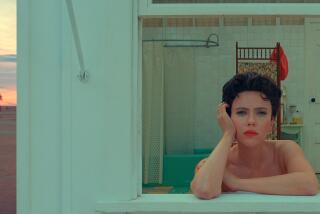‘Red Balloon’ homage floats easily
The first thing to get out of the way about “The Flight of the Red Balloon” is that this is not an action movie. It’s not even an active movie. Events don’t occur in the usual cinematic sense of cause begetting effect. It’s the kind of film that often gets called “lyrical” and “a meditation.” It’s a mostly non-narrative slice of uneventful life. Consider it duly disclaimered.
The 18th film by Taiwanese director Hsiao-hsien Hou, whose work has been nominated six times for the Palme D’Or at Cannes, “The Flight of the Red Balloon” is a homage to Albert Lamorisse’s “Le Ballon Rouge,” the nearly silent 1956 film abut a little boy who is followed around Paris by a giant red balloon. Depending on how you look at it, “Le Ballon Rouge” is either a joyful yawp or pretty scary, kind of like childhood itself. The little boy, played by Lamorisse’s son Pascale, is all but persecuted wherever he goes for daring to take his balloon around. Finally, he’s cornered by a gang of vicious elementary school thugs who pop the balloon, whereupon all the balloons in Paris flock to him and carry him off to God knows where.
Hou’s version, which is neither a remake nor a sequel, but, well, a meditation, is the story of Simon (Simon Iteanu), a little boy who lives with his mother Suzanne (Juliette Binoche) in a cramped, somewhat chaotic Parisian flat. Suzanne, who runs a puppet theater, is a single mother with platinum scrub-brush hair and an air of frantic desperation. She decides to hire a nanny to take care of Simon and finds Song (Song Fang), a Taiwanese film student studying in Paris.
Song and Simon take to each other instantly, beginning a collaboration on a movie about a boy and the red balloon that follows him around Paris. A relative newcomer to the country, the family, the neighborhood and the apartment, Song settles in uncomfortably at first, then quickly becomes indispensable to Suzanne.
Song provides the outsider’s view on a family situation. At first, she doesn’t understand Suzanne’s attitude toward her neighbors. Gradually, the source of her frustration is revealed, as are the complicated facets of her personal life. Simon, meanwhile, lives the life of a modern child. Unlike the boy in Lamorisse’s film, he has very little autonomy and no unsupervised moments. Also unlike him, Simon is the object of a great deal of affection. But still, some of the same loneliness pervades his life.
“The Flight of the Red Balloon,” which follows Hou’s acclaimed “Three Times,” is a great example of the director’s even-hand and assured command of the medium. Hou’s cinematographer Mark Lee Ping Bing keeps a distance from the characters, framing them in relatively long, static shots so that the characters move through them as if seen through a window, going on about their lives and their business in a way that feels almost voyeuristic at first. They tidy up their apartments, take piano lessons, talk on the phone about nothing. The camera is so unobtrusive and the acting so naturalistic that it takes a while for a narrative to emerge. When it finally does, you’re surprised to find you’re deeply invested in the characters.
The movie ends on a scene at the Musee d’Orsay, where Simon’s class is shown a painting of a little boy playing with a red ball and asked to decide whether the picture is happy or sad, and the children blurt out a cacophony of mixed opinions. Ultimately, “The Flight of the Red Balloon” feels so naturalistic and true to life that it can only be both.
--
--
“The Flight of the Red Balloon.” Unrated. Running time: 1 hour, 53 minutes. In French with English subtitles. In limited release.
More to Read
Only good movies
Get the Indie Focus newsletter, Mark Olsen's weekly guide to the world of cinema.
You may occasionally receive promotional content from the Los Angeles Times.










